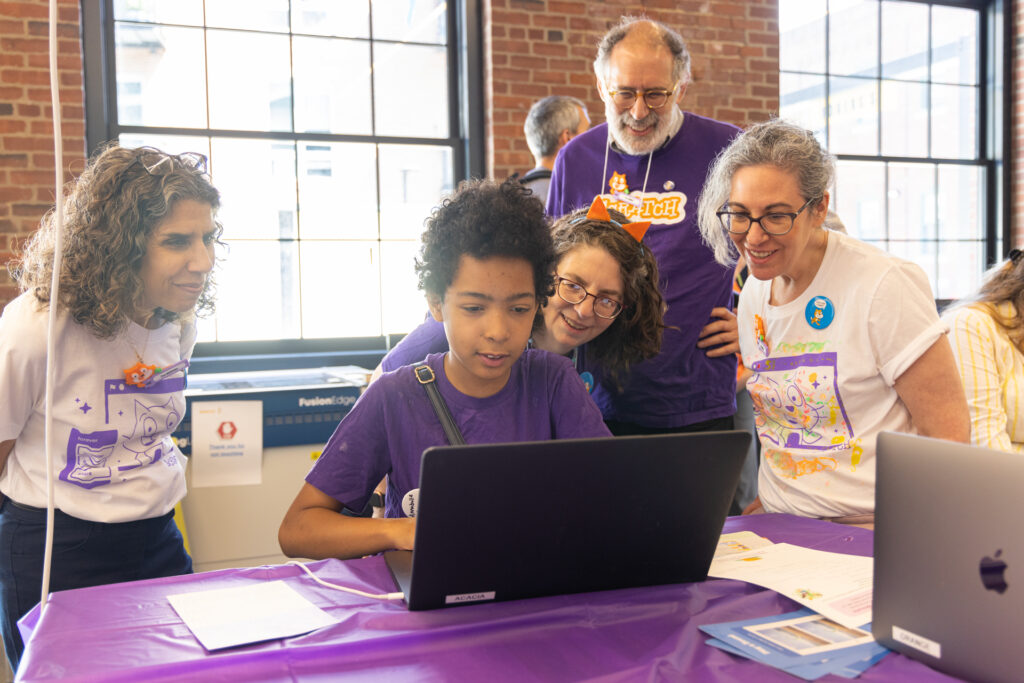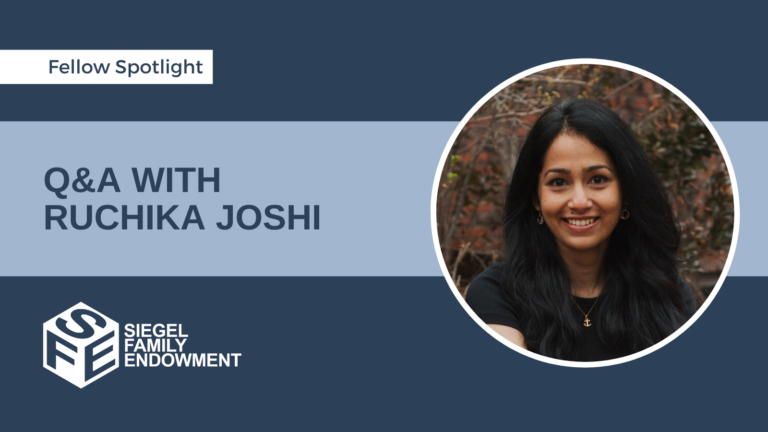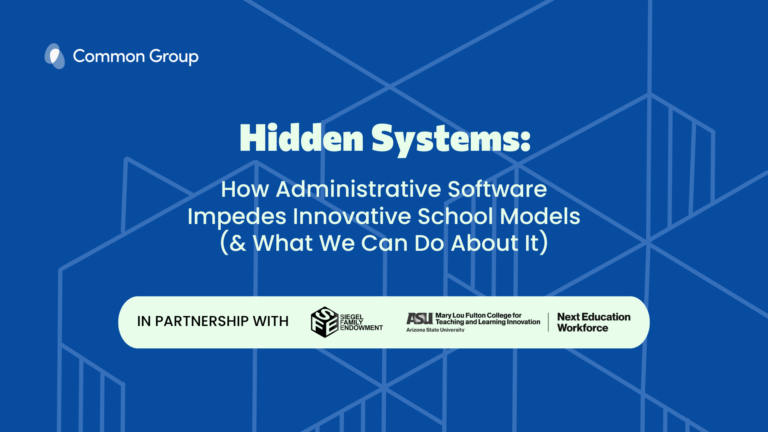
The Scratch Foundation’s New Co-Executive Directors Reflect on how the Platform is Building Community and Creativity Through a Pioneering Approach to Coding for Kids
Conjure up an image of students learning to code. You might imagine a solo pursuit—high schoolers wearing noise-canceling headphones or middle schoolers in front of black screens.
You might not picture a five-year old telling a story, or a ten-year old building upon a classmate’s project to create her own work. You might not imagine an online community of learners who helpfully offer pointers to one another. You might not see young learners sitting side-by-side, joyfully collaborating to animate a character they developed. You might not think of educators engaged in a community of practice to discuss how to help students build collaboration, creativity, resilience and other powerful skills and mindsets through coding. Yet, these images are all examples of the power of Scratch and ScratchJr, coding languages and a surrounding community for children and educators.
We sat down with Mindee Barham and Sarah Smirnoff, the Scratch Foundation’s new co-executive directors. In this joint interview, Mindee and Sarah discuss the power of Scratch for learners the world over, how Scratch helps facilitate the development of important skills and mindsets, how Scratch is developing community, and how the Scratch Foundation seeks to learn from its community in making its product and platform accessible and responsive to learners all around the world.
You were recently promoted to co-executive directors of the Scratch Foundation. However, you both have a longer history at the organization. Mindee previously served as chief philanthropy officer, and Sarah was chief product officer. In what ways have these experiences and roles—as well as your prior work as leaders in the nonprofit and education sectors—prepared you for leading the Scratch Foundation?
Sarah: When I started interviewing at Scratch, there was an almost instant connection for me about its approach. I think a lot of that came from my previous experience. I have 20 years of experience in educational technology products, education reform, and supporting kids and teachers in schools. But two key formative experiences were studying theater and teaching nursery school. All of my training through college was how to work collaboratively with people from a creative lens, and the other piece was working with our youngest learners. And these two things together set me up in a frame to always be thinking about creativity, and how to do it in a caring and collaborative way.
When I started to move into technology development, not only did I feel like the theater background had given me the training and understanding of how to work with multiple roles and people to collaboratively create something, it also gave me an ability to ask: ‘What do people really need? How do we work together on this? How do you do this in a way that results in something new, and something innovative?’
All of these pieces – the creativity, art, collaboration – came together when I I came in as the chief product officer at Scratch. It feels like this was the next role that I was really meant to do. I was really ready to go and combine a lot of these things, and hit the ground running.
Mindee: I come at this from having spent my whole career—really the last 30 years—in the non-profit sector in leadership positions. Initially I was on the program side, but transitioned to philanthropy, which opened up my interest in questions about sustaining organizations. I was trying to understand what is needed to drive an organization. How does philanthropy support the work that is happening at an organization?
I’ve always approached philanthropy with a very mission-centered approach, working on organizations that were focusing on education or human services or social services—always from the lens of working with disenfranchised populations or underserved communities, women, children, communities of color, and, most recently, working with low-income women, living in poverty, and issues around poverty alleviation.
So when I came to Scratch [as Chief Philanthropy Officer], I aimed to build a sustainable base to really be able to serve the mission of bringing this program, this product, to communities that didn’t have access to this kind of learning.
Now that you’ve been appointed co-executive directors of the Scratch Foundation, how do you plan to leverage these unique areas of expertise? Will you be dividing responsibilities or working together on all aspects of the organization?
Sarah: The guiding principle is that it’s still one organization. We’re not siloing responsibilities between us.
Mindee: At the same time, we do come at this from our complementary skill sets. Sarah is experienced on the product side and understands the technical aspects of our work. I come at it from understanding the resourcing and the philanthropy side. We split the managerial aspects of this work along those lines. Having those two ways of looking at the work, and our experiences combined, we do spend a lot of time together. We think through problem solving and vision together. We might lead together or separately, but with a shared vision, an agreement on how this work is going to play out.
Sarah: We spend a lot of time together.
Mindee: We really do! We’re here in-person in the office together!
You’ve referenced the collaboration and creativity skills and mindsets that students build through their use of Scratch. The intentionality about building those skills makes Scratch somewhat unique in the coding space. Why are these creative skills and mindsets important? How does using Scratch help students develop these skills?
Sarah: We know that 65% of primary school children are going to grow up to have jobs that don’t yet exist. These skills—critical thinking, collaboration, resilience—are the things that are going to help them be creative thinkers and have the kind of creative confidence they’re going to need for these jobs that don’t yet exist. We always say that we’re not building an army of coders. We are building a group of kids who will be able to be anything they want, and be able to effect change in the world. Those skills happen through coding, and are jump-started by Scratch.
Mindee: I was recently reminded of why that was so important. We’re not teaching kids to learn to code, but they’re coding to learn. They’re using coding as their vehicle for learning these different skills of collaboration, sharing, and problem solving. Technical skills are just one of the pieces that they’ll learn through this work.
Sarah: I want to give a shout-out to creative learning and how important it is to the foundation of Scratch. It’s through that ability to understand their passions and to be able to work together, and to build that sense of joy in learning that is also a contribution. Scratch does that so incredibly well.
What does it take to help children develop these skills that you referenced? How does Scratch help with that?
Mindee: Creative learning really emphasizes exploration. We don’t offer a prescriptive way to use Scratch. We provide resources and tutorials, but we’re not offering a curriculum on how to use Scratch. As a result, kids have the ability to explore and try things and fail, and try again. That’s an important lesson to be able to learn in that way.
Sarah: I spent a lot of time in my last job doing interviews in the workforce and understanding the skills that were lacking in adults. Almost all of the employers were not worried about technical skills. They were concerned about building resilience, creativity, and problem-solving. We haven’t given kids the opportunity to build those skills. I would argue that adults need to learn this way too. That’s one of the reasons why it’s so important for Scratch to be prioritized. We’re running a risk of schools not prioritizing this kind of learning.
Mindee: Part of our work is to support educators to have communities of practice in changing the way we introduce learning—and particularly Scratch—into their classrooms and communities. We do that through the Scratch educator meet-ups, bringing teachers together to talk about how they’re introducing Scratch. We do that through the Scratch Education Collaborative, where we’re both introducing this to other communities and learning from them on how they do this. Through this work, we’re talking about how to share Scratch and to use Scratch in this creative way, not in a prescriptive way or tied to too many requirements on what kids learn. The educators work together to make sure that this is a playful way of learning.
What are the biggest challenges to doing this work? What are some of the ways that you expect to tackle those challenges as co-executive directors?
Mindee: The pandemic posed a challenge and an opportunity in the field of education. It highlighted the inequities in education and the opportunities for learning while schools weren’t open and we were locked down. Having access to Scratch, a free online learning tool, was beneficial, especially to communities that didn’t have resources to do learning online in other ways.
We saw that there was exponential growth in the use of Scratch. Understanding how this could have an impact on communities—especially marginalized communities—has been a real focus of our work. That was true before, during, and now, as we plan into the future, post-pandemic.
There was this incredible organic growth of Scratch. Moving forward, we want to be really targeted about making sure it’s not just growth for growth’s sake, but growth that is responsive to where we see the need and where we see the opportunity. Through programs like the Scratch Education Collaborative, we’re focusing on tailoring growth to the needs of targeted geographic areas. For example, we have an emphasis on serving groups in the Asia Pacific region and in India. We see a lot of organizations that we can reach there, and through their reach we can have an exponential growth into the communities. However, those populations don’t always have the same technology, Internet, or bandwidth access. So we’re thinking about how our product can be used both online and offline.
Sarah: There’s also a negative side to organic growth. We need to make sure we’re keeping up from an infrastructure standpoint. We’ve grown really fast. We have to create sustainability and structure so that we can serve everyone. It’s a great problem to have, but it definitely comes with its own challenges.
One of the challenges to this work is that schools—which reach many students—typically have a lot of requirements. How do you manage those needs while keeping true to your unique approach at Scratch?
Sarah: We try to meet students and educators where they are. What do they need to use Scratch in their context? For example, how do we think about security requirements? How do we think about getting them additional resources? How do we think about bringing educators into working with other teachers and groups? We also try to make sure everything is translated and accessible. These are all high priorities for us.
Mindee: Even though our creative learning philosophy doesn’t directly line up with the computer science standards, we try to help teachers understand how to align some of the work that they’re going to do with Scratch. For example, New York City—the largest school district in the country—teachers are using Scratch in computer science classes across all levels, from K through 12. Teachers and school systems see it as such a valuable resource. We want to make sure that they can continue to use it, and use it as a way to help students meet their needs and the requirements.
One of the things that distinguishes Scratch from other coding platforms is that it explicitly aims to build community. How do you do this work?
Mindee: We’ve been talking a lot lately about the importance of wellness online, and take care to offer a safe and supportive online place for young people.
Sarah: One of the things that I find so compelling about the Scratch community is that it’s one of the few places where kids come together in this social way around creating something together, rather than consuming things. In other online contexts, you see kids consuming media that is not healthy for them. At Scratch, kids are taught by our moderators and the people who are doing engagement about healthy ways of interacting. We work on creating a positive community, creating a space where everyone can be themselves and have self-expression. They teach kids how to comment well, how to offer criticism in a nice way, and how to learn from each other. Kids can become Scratchers after engaging with the platform over a certain number of projects or a certain number of comments. As a Scratcher, they can help other kids.
Mindee: When somebody builds a project and then shares it online on Scratch, someone else can go and see the building blocks inside. They can see the code. They can learn from that, but they can also then take that, and copy it, and make it their own, and then learn how to build upon it, or change it, or model it in their own projects. They’re learning by seeing inside the project.
Sarah: These are such important skills, and our community is very unique in helping build those skills. We’re really excited to think about things like tech and wellness, and how to contribute even more in those conversations, and be a leader there.
And our community isn’t limited to online; for kids who don’t have online access, they may work together on Scratch in-person, in their classroom. What you really want are our kids who can sit side-by-side sometimes and say, ‘Hey, I like how you did that,’ or, ‘Can we try that?’ Or, ‘Maybe we can make another idea and work on that together.’ There’s tremendous value in both in-person and online collaboration. We want to figure out ways to build more in-person community through Scratch in the future.
I also want to give a shout-out to ScratchJr. We had a really great experience of seeing it introduced to a number of 4- and 5-year olds in a school in Harlem this past year. It’s tremendous to watch how the kids adapt a little bit differently and learn. A lot of kids’ first entry point in Scratch or ScratchJr is in drawing and creating something and then making that drawing move and change, and doing things with it. It’s exciting to see kids make those connections as they’re working through a project.
Mindee: They’re really learning through storytelling. That’s a hallmark of the Scratch Foundation’s work with both kids and educators.
How does the Scratch Foundation support this work?
Mindee: The Scratch Foundation was created to support the Scratch and ScratchJr platforms and products. We want to make sure that those platforms and products are sustainable and offered free of charge to children all over the world. The Scratch Foundation is the organization that hosts those platforms, and raises the revenue to support the people and the infrastructure to be able to provide those platforms.
Sarah: It’s making sure that the software is up-and-running every single day. We have developers, we have product folks, we have designers. We have teams of moderators who are making sure our kids are very safe in the community. We have folks who are bringing this out in the community. It’s also operational.
What are your priorities for Scratch and the Scratch Foundation in the future?
Mindee: Our Scratch Lab is innovating for the future and discovering and tinkering and imagining the future of Scratch.
Sarah: We’re still figuring out our exact plans as co-executive directors, but we do know that we want Scratch and ScratchJr to be around for a very long time and make sure they get to the kids who need them. Our biggest focus is on our business model and our revenue, and how we’re going to sustain this work, and continue to build it, and make sure it’s here and strong for the future.
But we think long and hard about the broader changes we want to see in education. We think about what it means to give kids the creative confidence so that they can keep growing and changing the world and moving in that direction. We are trying to figure out what is the vision we’re building and then figure out the steps to move there. Elements of that might include working on the editor, thinking about AI and learning, putting child wellbeing front-and-center in our community, and framing our learning philosophy.
MB: We also want to make sure that all of those pieces are accessible to all kids by making sure that Scratch is available in a variety of ways – both online and offline, in multiple languages, addressing any visual restrictions, or anything that might prevent people from using the platform.
We’re also focused on expanding opportunities for creative learning around the world by working with global organizations and partners. We want to focus on not only how to deliver a great product and experience to our partners, but how to learn from them and with them on how to continue to make Scratch localized in terms of both language accessibility and their specific contextual needs. We see an ecosystem of hubs of learning and expansion grounded in those communities.
####
Mindee Barham and Sarah Smirnoff are co-executive directors of the Scratch Foundation, a nonprofit organization that ensures that Scratch and ScratchJr. are available for free, for everyone, so that kids around the world can express their ideas through coding.





